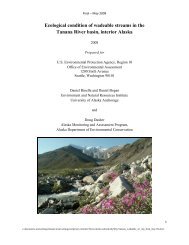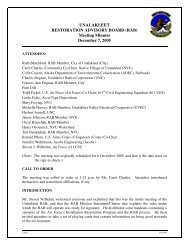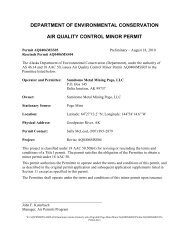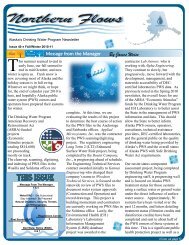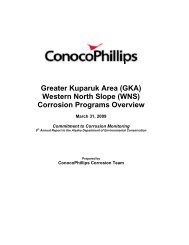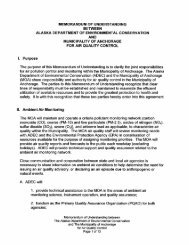2012 Ocean Ranger Guidebook Revision 3-7-12 - Alaska ...
2012 Ocean Ranger Guidebook Revision 3-7-12 - Alaska ...
2012 Ocean Ranger Guidebook Revision 3-7-12 - Alaska ...
Create successful ePaper yourself
Turn your PDF publications into a flip-book with our unique Google optimized e-Paper software.
<strong>20<strong>12</strong></strong> <strong>Ocean</strong> <strong>Ranger</strong> <strong>Guidebook</strong> 3-7-<strong>12</strong><br />
A. Hazardous Waste Collection and Storage onboard Ship: CLIA member lines have<br />
agreed that specific procedures for hazardous waste collection, storage and crew<br />
training will be addressed in each ship’s SMS or equivalent onboard instruction in the<br />
Case of US registry vessels.<br />
B. Photo Processing, Including X-Ray Development Fluid Waste: CLIA member<br />
lines have agreed to eliminate the discharge of silver from these sources into the<br />
marine environment through the use of best available technology that will reduce the<br />
silver content of the waste stream below levels specified by prevailing regulations or<br />
by treating all photo processing and x-ray development fluid waste (treated or<br />
untreated) as a hazardous waste and landing ashore in accordance with RCRA<br />
requirements.<br />
There are several waste streams associated with photo processing operations that have the<br />
potential to be regulated under the Resource Conservation and Recovery Act (RCRA). These<br />
waste streams include spent fixer, spent cartridges, expired film and silver flake.<br />
Photographic fixer removes the unexposed silver compounds from the film during the<br />
developing process. The spent fixer can have as much as 2000-3000 parts per million (ppm) of<br />
silver. Silver bearing waste is regulated by RCRA as a hazardous waste if the level of silver<br />
exceeds 5 ppm as determined by the Toxicity Characteristic Leaching Procedure (TCLP) test.<br />
Silver recovery units may be used to reclaim the silver from the used fixer waste stream.<br />
There are two types of recovery units. These are active (with electricity) and passive (without<br />
electricity) units. The active unit uses electricity to plate silver onto an electrode. The passive<br />
unit uses a chemical reaction between steel wool and silver to remove most of the silver from<br />
solution. Utilizing the best available technology, the equipment currently onboard CLIA<br />
member cruise ships is conservatively estimated to reduce the silver content of this effluent below<br />
4 mg/l (milligrams/l or ppm)<br />
Handling Method 1 Employed by Member Lines:<br />
Treat used photographic and x-ray development fluids to remove silver for recycling.<br />
Verify that the effluent from the recovery unit is less than 5 parts per million (ppm) silver, as<br />
measured by EPA-approved methodology.<br />
After treatment, the residual waste stream fluid is non-hazardous and landed ashore as industrial<br />
waste.<br />
Handling Method 2 Employed by Member Lines:<br />
Used photographic and x-ray development fluids, either treated or untreated, may be assumed to<br />
be a hazardous waste. In this event, they are landed ashore in accordance with the requirements<br />
of the Resource Conservation and Recovery Act (RCRA).<br />
C. Dry-cleaning waste fluids and contaminated materials: CLIA member lines have<br />
agreed to prevent the discharge of chlorinated dry-cleaning fluids, sludge,<br />
contaminated filter materials and other dry-cleaning waste byproducts into the<br />
environment.<br />
136






